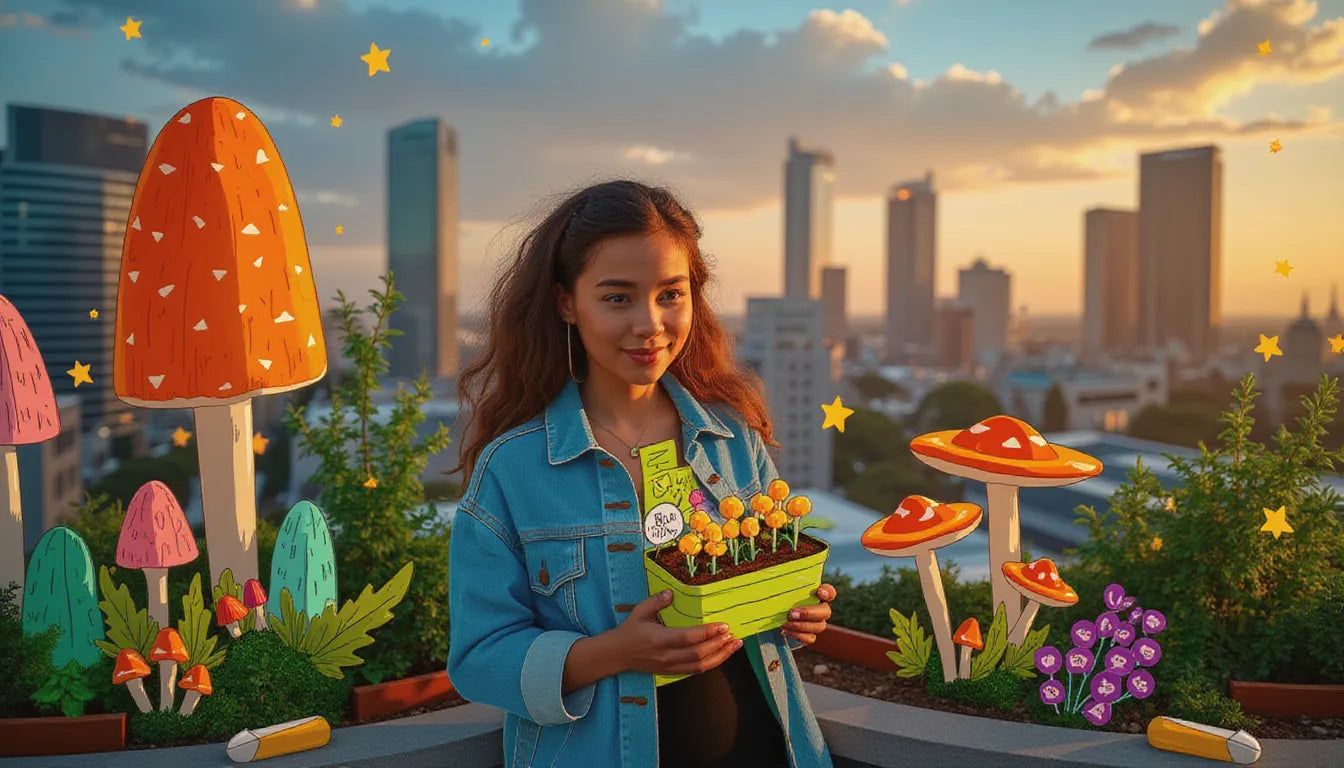⬇️ Prefer to listen instead? ⬇️
- Urban farming can reduce food transport emissions by up to 10%.
- Nearly 30% of the global population lacked access to adequate food in 2020.
- Hydroponic systems use up to 90% less water than traditional agriculture.
- Green rooftops help manage stormwater and decrease the urban heat island effect.
- Cities like Detroit and Singapore are leading urban agriculture initiatives with measurable success.
As cities rapidly expand and climate pressures mount, urban farming has emerged as a powerful way to make cities greener and stronger. What was once seen as an environmentally conscious niche is now a growing movement that affects many parts of life in cities: social, economic, and environmental. When cities put local farming into their plans, communities can change how food gets around, make sure more people have enough food, and build lasting cities for the future. Our monotubs give urban farmers a simple, space-saving way to grow fresh mushrooms right at home, making sustainable city living easier and more productive.

What Is Urban Farming? A Modern Agriculture Movement
Urban farming, also known as urban agriculture, refers to the practice of cultivating, processing, and distributing food in and around cities. It includes many activities and ways of doing things, including:
- Rooftop gardens: Turning unused roof space into productive green plots.
- Vertical and indoor farms: Using walls or hydroponic towers to grow food vertically, often indoors with artificial lighting.
- Hydroponics and aquaponics: Soil-free systems that grow plants in nutrient-rich water, sometimes alongside fish for a symbiotic ecosystem.
- Container and backyard gardens: Utilizing small containers, raised beds, or home yards to grow fruits, vegetables, and herbs.
- Mushroom cultivation: Growing fungi in small indoor spaces using composted or recycled materials.
These strategies prioritize efficiency, adaptability, and minimized land use — perfect for urban settings where ground-level space is limited or expensive. The guiding philosophy of urban farming is to produce food as close as possible to where it will be consumed. This reduces the ecological footprint associated with food transportation, processing, and storage while deepening the connections between people and their food sources.

Sustainable Cities: The Urban Farming Connection
Sustainable cities aim to minimize their environmental impact while improving quality of life for residents. Urban farming is a key part of making cities like this.
According to the U.S. Environmental Protection Agency (2022), localized food production can reduce food transport emissions by up to 10%, depending on factors like scale and proximity to consumers. By removing the need for long-haul transportation, farming within city limits significantly cuts greenhouse gas emissions, curbs fossil fuel use, and minimizes refrigeration and packaging requirements.
But the advantages extend far beyond emissions:
- Cooling urban heat islands: Farms and gardens absorb sunlight and transpire water — processes that cool the air.
- Improving air quality: Plants filter particulate pollutants and release oxygen.
- Managing stormwater: Green roofs and gardens absorb rainfall, reducing runoff and lowering flood risks.
- Boosting biodiversity: Edible green spaces support pollinators, birds, and beneficial insects.
This way, urban farming helps cities not only feed people in a lasting way but also physically change as the climate changes. It helps with city planning, the environment, and making communities stronger.

Boosting Food Security With Localized Production
Food security — defined as consistent access to sufficient, safe, and nutritious food — is a growing concern for urban populations globally. The Food and Agriculture Organization (2020) reported that nearly 30% of the world’s population was food insecure in 2020, a statistic that shows how fragile food systems around the world are right now.
In wealthy nations, "food deserts" — areas with limited access to affordable and nutritious food — exist within urban environments, often in low-income or marginalized neighborhoods. Residents in these communities may rely on convenience stores or fast food due to a lack of grocery stores or fresh produce vendors nearby.
Urban farming addresses this disparity by:
- Creating hyperlocal sources of fresh produce.
- Reducing the cost and complexity of supply chains.
- Enabling community-driven food distribution.
- Integrating food literacy programs into schools and communities.
Localized food systems also make people healthier. Eating lots of fresh produce means lower rates of obesity, diabetes, and heart disease. These problems often get worse in food deserts. Urban farming doesn't just give people food. It does it in a way that keeps them healthy and gives communities more power.

The Environmental Benefits of Urban Growing Spaces
Urban farming shows how we can grow things that also help fix the environment. Its direct and indirect environmental benefits include:
Fewer Food Miles
Transporting food long distances vastly increases its carbon footprint. Local urban farming cuts down the "food miles"—how far food travels from the farm to your plate. This lowers emissions from transport. Plus, with local delivery or direct-to-consumer models, packaging needs are minimized.
Composting Systems
Many urban farms use composting to handle organic waste. Food scraps, coffee grounds, and yard trimmings are broken down into nutrient-rich compost, which feeds the soil — or hydroponic solutions — for the next crop cycle.
Water Conservation
Hydroponic and aquaponic systems use up to 90% less water than traditional agriculture because they recirculate water rather than letting it run off. Drip irrigation, rainwater harvesting, and greywater recycling also make urban farms models of water efficiency.
Urban Biodiversity
Urban farming spaces serve as micro-habitats within the concrete jungle. They attract bees, butterflies, birds, and beneficial insects. Bigger projects can add native plants and trees to help more kinds of life grow. This makes the local environment stronger.
Urban agriculture doesn’t just use resources. It helps make them new again. It helps build the kind of green systems cities really need.
Local Economic Growth Through Microproduction
Urban farming helps local people have more control over their food. It also helps local economies by turning empty lots, rooftops, and unused spaces into places that make money. When small-scale farming grows, it helps in many ways:
- Job creation: From farm managers and greenhouse technicians to delivery drivers and educators.
- Entrepreneurship: Small-scale farmers can build direct-to-consumer brands through farmers' markets, CSAs (Community Supported Agriculture), co-ops, and e-commerce platforms.
- Skill development: Many urban farm projects include training programs in agriculture, technology, food safety, and business management.
Urban farming helps the local economy grow in different ways. It lowers unemployment and helps people start their own businesses, especially for those who don't have many chances now. It gives city residents the ability to earn a living by feeding their communities.

Mushrooms: A Powerful Urban Crop
Mushrooms use little space and are easy for beginners. They are a great way to start urban farming. They’re fungi, not plants, and can be cultivated in dark, damp environments — no sunlight required.
Key benefits of urban mushroom farming:
- Minimal space: Grows almost anywhere—closets, garages, basements.
- Fast yields: Some mushrooms mature in as little as two weeks.
- Grows on waste: Many types thrive on recycled materials like sawdust or spent coffee grounds.
- Nutritional profile: High in protein, vitamin D, B-vitamins, fiber, and antioxidants.
Both businesses and people at home like growing mushrooms because they grow fast, don't need many resources, and people want to buy them, especially fancy or health-focused types. Brands like Zombie Mushrooms make kits that are easy to use. Anyone can use them to turn a kitchen cupboard into a small farm.

Urban Farming as a Wellness and Community Movement
The benefits of urban farming aren’t just ecological or economic — they’re psychological and social, too.
Studies show that engaging in gardening reduces cortisol (the stress hormone), improves mood, and promotes physical activity. Whether someone is tending rooftop tomato plants or nurturing a mushroom block, the act of growing food creates mindfulness and routine.
Community gardens and urban farms also:
- Help neighbors feel more connected.
- Help connect people from different ages and backgrounds.
- Serve as gathering places for education, meals, and events.
In crowded cities, these shared green spots can be special places where people connect and work together. They show us not just how we eat, but how we can live together.

Putting Innovation to Work: Vertical Farming, Hydroponics, and Tech Solutions
Technology is changing how cities grow food. As traditional horizontal farmland becomes scarce or inaccessible, urban agriculture is turning upward and inward with tools like:
- Vertical farms: Layers of plants grown on racks indoors using LED grow lights.
- Automated hydroponics: Self-watering and nutrient-cycling systems optimized with AI and sensors.
- Data-driven farming: Internet of Things (IoT) devices track moisture, temperature, and nutrients in real time for optimized growth.
These innovations allow for:
- Year-round production: Controlled environments mean consistent output regardless of weather.
- Land efficiency: High yields per square meter.
- Reduced inputs: Less water, no pesticides, reduced transportation.
Singapore’s urban agtech sector, for example, is producing greens in shipping containers and high-rises — setting an example for land-scarce cities worldwide.

Challenges: Infrastructure, Policy, and Perception Barriers
Despite its potential, urban farming faces systemic barriers:
Outdated Zoning Laws
Many cities lack clear definitions around agriculture, particularly indoor or vertical farming. Zoning laws can prevent growers from selling produce commercially or even planting in visible front yards.
Limited Access to Space
Securing affordable land or rooftop rights can be expensive and bureaucratic. Additionally, urban soil may be contaminated and unsuitable for food production, requiring raised bed solutions or hydroponics.
Lack of Policy Support
Cities might not see farming as important in their plans. They might not offer help like tax breaks, grants, or training.
Public Perception
Urban farming is still often seen as a recreational or symbolic activity, rather than a serious part of the food supply chain. We need to change these ideas if we want urban farming to make a bigger difference.
People need to speak up for urban farming. Policies need to change, and cities need to spend money on things like land and water systems. This is how urban farming can become a regular part of city life.

Case Studies: Cities Turning to Urban Agriculture for Solutions
Multiple cities around the world are setting precedents:
- Detroit: Over 1,500 active urban gardens repurpose abandoned lots and help build community pride, education, and food access.
- Singapore: High-density high-tech farms on rooftops and vertical systems contribute to national food resilience goals.
- Paris: Ahead of their 2020 goal, the city mandated that 100 hectares of building rooftops and walls be transformed into green, food-producing spaces.
These examples show that urban farming can grow big. They show how rules, technology, and community effort work together to make cities last.

How Urban Farming Helps Cities Handle Climate Change
When it comes to handling climate change, urban farming helps cities in two ways: it helps when bad things happen, and it helps prevent problems. Local farms:
- Provide food stability during disasters or supply disruptions.
- Absorb stormwater during heavy rainfall, reducing urban flooding.
- Cool overheated city blocks, reducing cooling energy needs.
- Lower carbon footprints through reduced logistics.
Urban farming can be a smart way to protect cities from climate problems. It gives food and helps cities and the people in them handle tough times better.

Getting Started with Small-Scale Urban Growing at Home
You don’t need to be a city planner to help make cities last — you can start in your own apartment. Begin with:
- Herb gardens: Basil, mint, parsley, and chives grow easily on windowsills.
- Mushroom kits: Like those from Zombie Mushrooms, require no sunlight or yard space.
- Indoor hydroponics: Compact towers and smart gardens enable lettuce, strawberries, and more.
- Balcony containers: Tomatoes, peppers, and greens thrive with just a few hours of sunlight.
Starting to grow food doesn't just give you fresher food. It connects you to bigger goals around the world: making sure everyone has food and taking care of the environment.
The Future: Will City Planning Always Include Urban Farming?
Climate problems are getting worse, resources are getting harder to find, and more people are living in cities. Smart city planning is starting to include more local farming. The National League of Cities (2019) says more cities are making rules to help urban farming. But full plans for it are still being worked out.
Partnerships between city governments, private companies, and community groups will be key to creating urban farming policies that support:
- Funding for startups and retrofit projects.
- Permitting and zoning reform.
- Public education and awareness campaigns.
- Integration into school, hospital, and housing programs.
The cities of tomorrow will include farms in ways that feel as standard as sidewalks and streetlights today.
Why Growing Local Might Be the Most Global Solution There Is
Cities are our future — and food must be a part of how they grow. Urban farming helps meet big needs in the 21st century: getting enough food, taking care of the planet, being fair to everyone, and building community. Whether you grow mushrooms in your kitchen or help make rules for a city block, supporting urban farming helps make a healthier, stronger future.
Citations
- Food and Agriculture Organization of the United Nations. (2020). The State of Food Security and Nutrition in the World.
https://www.fao.org/3/ca9692en/CA9692EN.pdf - U.S. Environmental Protection Agency. (2022). Benefits of Urban Agriculture.
https://www.epa.gov/sustainable-management-food/benefits-urban-agriculture - United Nations Department of Economic and Social Affairs. (2018). 68% of the World Population Projected to Live in Urban Areas by 2050.
https://www.un.org/development/desa/en/news/population/2018-revision-of-world-urbanization-prospects.html - National League of Cities. (2019). Planning for Urban Agriculture.
https://www.nlc.org/resource/planning-for-urban-agriculture/ - American Planning Association. (2021). Urban Agriculture — Policy and Practice.
https://www.planning.org/pas/reports/report318/



